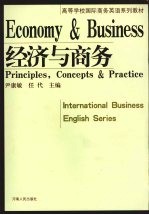

经济与商务PDF电子书下载
- 电子书积分:13 积分如何计算积分?
- 作 者:尹康敏,任代主编
- 出 版 社:郑州:河南人民出版社
- 出版年份:2007
- ISBN:9787215062351
- 页数:374 页
Part Ⅰ Principles and ConceptsEconomy&BusinessChapter 1 Economics Basics 3
1.1 Why Study Economics? 3
1.2 What Is Economics All about? 4
1.3 Scarcity 4
1.4 Big Ideas of Economics 5
1.5 Trade-offs 6
1.6 Opportunity Costs 6
1.7 Production Possibilities Frontier(PPF) 7
1.8 Utility 8
Chapter 2 The Economic Systems 16
2.1 What Is an Economic System? 16
2.2 Two Major Competing Economic Systems 16
2.3 The Market System 19
2.4 Characteristics of the Market System 21
2.5 Market Reforms in China 23
Chapter 3 Market Pricing 30
3.1 What Is a Market? 30
3.2 Demand and Supply 31
3.3 Supply and Demand Relationship 33
3.4 Equilibrium and Disequilibrium 33
3.5 Elasticity 35
3.6 Price and the Market Price 38
Chapter 4 Macroeconomics and Microeconomics 44
4.1 What's the Difference between Macroeconomics and Microeconomics? 44
4.2 Inflation and Deflation 45
4.3 Unemployment 46
4.4 Monetary Policy 47
4.5 Fiscal Policy 48
4.6 Applied Microeconomics 49
Chapter 5 Marketing 58
5.1 What Is Marketing? 58
5.2 Needs,Wants and Demands 59
5.3 The Determinants of Individual Demand 60
5.4 Purpose of Marketing 60
5.5 Exchange Is the Focus of Marketing 61
5.6 Market Segmentation 62
5.7 Quality in Marketing 62
5.8 Concepts in Marketing 63
5.9 Relationships in Marketing 65
5.10 Internet and Marketing 66
5.11 Model of Marketing 66
Chapter 6 Legal Forms of Business Organizations 75
6.1 Introduction 75
6.2 Sole Proprietorship 76
6.3 General Partnership 77
6.4 Limited Partnership 78
6.5 Limited Liability Partnerships 79
6.6 Limited Liability Company 80
6.7 Corporations 81
6.8 Traditional Cooperatives 83
6.9 Other Forms of Business Organizations/Combinations 85
6.10 Conclusion 86
Chapter 7 Distribution Channels 92
7.1 The Definition of a Distribution Channel 92
7.2 Functions of Intermediaries 92
7.3 Channel Members 93
7.4 Wholesale Distribution of Consumer Products 95
7.5 Retail Distribution 97
7.6 Market Intensity 100
7.7 Channel Management 100
7.8 Physical Distribution 101
Chapter 8 Marketing Communications 111
8.1 Introduction 111
8.2 Model of Communication 111
8.3 Promotional Mix 114
8.4 Advertising 117
8.5 Sales Promotion 119
8.6 Public Relations 120
8.7 Direct Marketing 120
8.8 Sponsorships 121
Chapter 9 The International Economy 131
9.1 What Is International Economics? 131
9.2 Reasons for Trade 132
9.3 Some Trade Terminology 134
9.4 What Is International Business? 135
9.5 The Scope of International Business Activities 135
9.6 International Risk 136
9.7 The Introduction to the WTO 137
Chapter 10 International Finance 149
10.1 Trade Imbalances 149
10.2 The Balance of Payments 150
10.3 The Foreign Exchange Market-Definitions 151
10.4 Exchange Rate Systems 156
Chapter 11 Entrepreneurship and Change 165
11.1 Overview 165
11.2 Dream 166
11.3 Preparing for the Adventure 168
11.4 Business Options 170
11.5 Lifestyle Considerations 172
11.6 Characteristics of the Successful Entrepreneur 173
Chapter 12 Principles of Business Ethics 184
12.1 Overview 184
12.2 Make an Ethical Decision 185
12.3 Business Education-Ethics and New Professionals 187
12.4 Socially Responsible Business-Doing the Right Thing 188
12.5 Intellectual Property:Yours,Mine,and Ours 190
12.6 Quality Standards 191
12.7 Marketing with a Conscience:Sales and Ethics 193
12.8 Corporate Wrongdoing:Corruption,Bribery,Scandals,etc 195
Part Ⅱ Practice 209
Business English Correspondence and ConversationChapter 13 Format of Business Correspondence 209
Chapter 14 Establishing Business Relationship 215
Chapter 15 Inquiry and Quotation 230
Chapter 16 On Price 253
Chapter 17 Ordering 272
Chapter 18 Contract 287
Chapter 19 Terms of Payment 307
Chapter 20 Shipment 327
Chapter 21 Claims and Arbitration 348
Chapter 22 Agency 357
Apppendix Some Commonly Used INCOTERMS 371
- 《信息系统安全技术管理策略 信息安全经济学视角》赵柳榕著 2020
- 《商务英语口译教程 第3版》朱佩芬,徐东风编著 2017
- 《革命根据地军事经济史》龚泽琪主编 1994
- 《实用商务英语听说 第1册》窦琳,江怡平主编 2019
- 《英语实训教程 第2册 商务英语听说》盛湘君总主编 2019
- 《近代民营出版机构的英语函授教育 以“商务、中华、开明”函授学校为个案 1915年-1946年版》丁伟 2017
- 《手工皮艺 时尚商务皮革制品制作详解》王雅倩责任编辑;陈涤译;(日)高桥创新出版工坊 2019
- 《经济侵略与中国》高尔松,高尔柏 1925
- 《面向可持续发展的马克思主义经济科学研究》刘正刚,李晓,田军著 2018
- 《环境启动经济》张继亮 2019
- 《办好人民满意的教育 全国教育满意度调查报告》(中国)中国教育科学研究院 2019
- 《人民院士》吴娜著 2019
- 《中国人民的心》杨朔著;夕琳编 2019
- 《考古郑州》任伟,刘彦锋著 2019
- 《中华人民共和国成立70周年优秀文学作品精选 短篇小说卷 上 全2册》贺邵俊主编 2019
- 《中华人民共和国成立70周年优秀文学作品精选 中篇小说卷 下 全3册》洪治纲主编 2019
- 《中华人民共和国药典中成药薄层色谱彩色图集》(中国)国家药典委员会 2019
- 《北京人民艺术剧院剧本系列 白露》刘国华,马鹏程 2019
- 《中华人民共和国成立70周年优秀文学作品精选 中篇小说卷 上 全3册》洪治纲主编 2019
- 《中华人民共和国国歌 钢琴谱》聂耳编 2019
